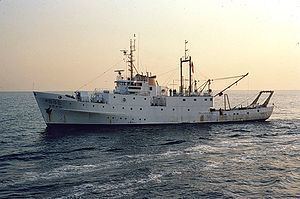Name BCF Albatross IV Namesake Previous name retained Length 57 m Endurance 15 days 0 hours | Commissioned 9 May 1963 Launched April 1962 Weight 1,106 tons Builder Slidell | |
 | ||
Namesake USFC Albatross, a famed U.S. Fish Commission vessel in commission 1882-1898, 1898-1917, and 1919-1921; RV Albatross II, a U.S. Bureau of Fisheries vessel in commission 1926-1932, and RV Albatross III, a U.S. Fish and Wildlife Service vessel in commission 1948-1959 Fate Transferred to national Oceanic and Atmospheric Administration 3 October 1970 Name NOAAS Albatross IV (R 342) | ||
NOAA Ship Albatross IV (R 342), originally BCF Albatross IV, was a fisheries research ship in commission in the United States Fish and Wildlife Service's Bureau of Commercial Fisheries from 1963 to 1970 and in the National Oceanic and Atmospheric Administration (NOAA) from 1970 to 2008.
Contents
Construction and characteristics
Albatross IV was built at Southern Shipbuilding in Slidell, Louisiana. She was launched in April 1962.
The ice-strengthened hull of the ship was 187 feet (57 meters) long. The ship had a total of 38 bunk spaces. Between the crew and officers mess rooms, the ship could seat 21 for meals. She carried a complement of 21—4 NOAA Corps officers, 1 civilian officer, and 16 crew (including 3 licensed engineers—and in addition could accommodate up to 14 scientists.
Her deck equipment featured four winches, one boom crane, an A-frame, a J-frame, and a portable gantry. This equipment gave Albatross IV a lifting capacity of up to 10,000 pounds (4,530 kilograms) as well 20,000 feet (6,090 meters) of cable that can pull up to 16,000 pounds (7,250 kilograms). Each of the winches serves a specialized function ranging from trawling and dredging to hydrographic surveys.
In support of her primary mission of fishery and living marine resource research for the National Marine Fisheries Service (NMFS) division of NOAA, the ship had shallow- and deep-water echo sounders, a fishfinder, and an Acoustic Doppler Current Profiler (ADCP). Additional scientific equipment included a thermosalinograph and a fluorometer. She had 800 square feet (74 square meters) of laboratory space with specialty labs for plankton and oceanographic chemistry. A 16-foot (4.8 m) launch was available for utility or rescue operations.
Service
BCF Albatross IV was commissioned into service in the U.S. Fish and Wildlife Service's Bureau of Commercial Fisheries on May 9, 1963. When NOAA was established on 3 October 1970 and took over the Bureau's assets, she became part of the NOAA fleet, redesignated NOAAS Albatross IV (R 342).
Based at Woods Hole, Massachusetts, Albatross IV conducted fisheries and living marine resources research off the northeastern coast of the United States.
On May 12, 1986, shipyard workers were working in Albatross IV's marine sanitation device compartment when one of them accidentally set off the compartment's fixed carbon dioxide firefighting system. Although the other workers escaped, one man, Kelly Prince, passed out in the compartment. He would have suffocated, but three members of the ship's crew – NOAA Corps Lieutenant Dean Smehil, civilian third assistant engineer Daniel J. Parry, and the ship's executive officer – put on Scott air packs and crawled into the very tight compartment. In moments, Smehil and Parry dragged the unconscious Prince from the compartment to safety, saving his life. For their heroism, Smehil and Parry received the Department of Commerce Gold Medal in 1986.
Albatros IV was decommissioned on November 20, 2008. She now is inactive in NOAA's Atlantic Fleet.
